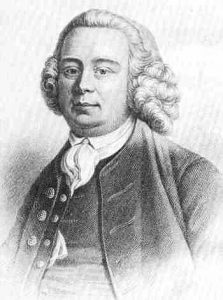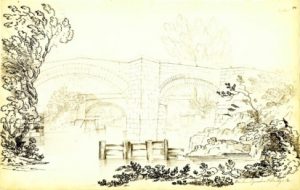(James Brindley a pioneer in canal building and a brilliant civil engineering designed a number of important canals and made a number of inventions. He played a significant role in developing the way canals were built during the Industrial Revolution transforming the British landscape and helping to unlock a new aspect of the Industrial Revolution).
 James Brindley was born at Tunstead, near Buxton, Derbyshire. He moved with his family to Leek to farm as a labourer. In his spare time he carved model windmills with a small pocket knife which were then geared to turn a paddle wheel which highlighted his innate practical ability. In 1733 he was apprenticed for seven years to a wheelwright Abraham Bennett who lived in Sutton near Macclesfield. Bennett was not a good master spending most of his time drinking and neglecting his duties to the apprentice Brindley. As a result he learnt very little but gradually started teaching himself having to carry out emergency repairs whilst Bennett was absent. In the autumn of 1735 a small silk mill at Macclesfield and owned by Michael Daintry was damaged and Bennett allowed Brindley carry out the repairs. He impressed the mill superintendent James Milner who predicted that Brindley would become a gifted craftsman. With Milner’s support and encouragement after he finished the Daintry Mill other mill owners approached him and this work expanded both in scale and range. People often asked him how he had become a good worker and often said ‘it came natural-like’ and he was called ‘the Schemer’. Bennett at first thought Brindley was a bungler in-spite of not supporting him but soon realised Brindley was a very skilled and became Bennett’s right hand man after the work for Daintry’s mill and as a result this saved Bennett’s business which ten gained its professional reputation. He remained with Bennett after his apprenticeship ended, running the business until his employer’s death.
James Brindley was born at Tunstead, near Buxton, Derbyshire. He moved with his family to Leek to farm as a labourer. In his spare time he carved model windmills with a small pocket knife which were then geared to turn a paddle wheel which highlighted his innate practical ability. In 1733 he was apprenticed for seven years to a wheelwright Abraham Bennett who lived in Sutton near Macclesfield. Bennett was not a good master spending most of his time drinking and neglecting his duties to the apprentice Brindley. As a result he learnt very little but gradually started teaching himself having to carry out emergency repairs whilst Bennett was absent. In the autumn of 1735 a small silk mill at Macclesfield and owned by Michael Daintry was damaged and Bennett allowed Brindley carry out the repairs. He impressed the mill superintendent James Milner who predicted that Brindley would become a gifted craftsman. With Milner’s support and encouragement after he finished the Daintry Mill other mill owners approached him and this work expanded both in scale and range. People often asked him how he had become a good worker and often said ‘it came natural-like’ and he was called ‘the Schemer’. Bennett at first thought Brindley was a bungler in-spite of not supporting him but soon realised Brindley was a very skilled and became Bennett’s right hand man after the work for Daintry’s mill and as a result this saved Bennett’s business which ten gained its professional reputation. He remained with Bennett after his apprenticeship ended, running the business until his employer’s death.
He was approached in 1750 by the brothers Wedgewood John and Josiah who were operating a small pottery business near Stoke but were struggling in getting sufficient powdered flint an essential material for the pottery. Brindley then built mills which could produce flint powder at Burlsem located near Leek. The following ten years he worked on a number of water and wind mills and became interested in steam engines and subsequent installed several atmospheric engines. Josiah Wedgewood invited Brindley to join the Lunar Society (see website)
As his reputation grew he was approached by John Heathcote owner of the Clifton collieries near Manchester to drain his mines which were flooding and that the traditional methods at that time were not effective. This was his most ambitious project when he created a drainage scheme that took water from the River Irwell through an underground tunnel over 731 metres long that ran under the river to drive an overshot wheel, which then pumped out the mine. This achievement highlighted his brilliance at engineering skills, knowledge of hydraulic problems and innovation
 He also built five tunnels and a number of aqueducts at Harecastle, Hermitage, Barnton, Saltenford, Preston-on-the Hill and Barton. Harefield tunnel was not completely finished until 1777 five years after Brindley’s death and was at the time the longest man-made tunnel on the world being approximately 2,750 metres. The quality and scope of his work catapulted him into a national figure. Eventually he became a rich person and in his will left £7,000 a considerable sum in those days in-spite of money owed to him by the Duke of Bridgewater estate and other sponsors. Barton is shown below.
He also built five tunnels and a number of aqueducts at Harecastle, Hermitage, Barnton, Saltenford, Preston-on-the Hill and Barton. Harefield tunnel was not completely finished until 1777 five years after Brindley’s death and was at the time the longest man-made tunnel on the world being approximately 2,750 metres. The quality and scope of his work catapulted him into a national figure. Eventually he became a rich person and in his will left £7,000 a considerable sum in those days in-spite of money owed to him by the Duke of Bridgewater estate and other sponsors. Barton is shown below.
Brindley suffered from diabetes throughout his life and this coupled with his incredible workloads resulted in his final illness whilst surveying the Trent and Mersey canal at Froghall and subsequent death at the age of 56. He is buried at St James, Newchapel Staffordshire.
Below are some achievements of James Brindley:
1716 Born at Tunstead, Derbyshire.
1726 Brindley family moved to Leek.
1733 Apprenticed to Bennett.
1737 Completes machinery of paper –mill for Bennett who realises what an excellent apprentice he has.
1742 He starts business as a millwright in Leek.
1750 Opens workshop at Burslem and in 1752 builds Leek Mill and starts Clifton Hydraulic Power Scheme.
1752 Constructs Leek Mill and Clifton Power Scheme.
1756 Builds a steam engine at Little Fenton and in 1758 patents a steam engine.
1758 Designed windmill to grind flint for Joseph Wedgewood. Patents design for a steam engine boiler.
1759 Partnership with Duke of Bridgewater begins.
1761 Barton Aqueduct opens to traffic.
1762 Surveys for the Chester Canal and Branch Canal to Stockport carried out.
1763 Provides advice on the Lower Avon Navigation improvements.
1764 Supervises construction of Bridgewater Canal.
1765 Appointed Engineer to the Calder and Hebble Navigation.
1766 Starts work on the Grand Trunk Canal.
1767 Surveys for Bradford, Rochdale and Stockton and Darlington Canals carried out.
1768 and 1769 Surveys for the Leeds and Liverpool, Leeds and Selby and Oxford canals carried out.
1770 Draws up plans for the Thames navigation improvements.
1771 The construction of the Chesterfield Canal starts
1772 Survey for the Lancaster Canal. Died on 27th September.
References:
Bode, H. ‘James Brindley. An illustrated life of James Brindley 1716-1772.’ Shire Publications Ltd. ISBN 0 85263 485 4. Lifelines series 14. 1992.
Boucher, C. T. G. ‘James Brindley Engineer, 1716-1772.’ Goose and Son.
Evans, K. M. ‘James Brindley, Canal Engineer – a New Perspective.’ ASIN B00LUVLMU0. Churnet Valley Books (Bath Street, Leek). 1998.
Halward, L. ‘Famous British Engineers.’ The Scientific Book Club.
Smiles, S. ‘James Brindley and the Early Engineers.’1864. Reprinted by Hanse. ISBN 9783744662192.
The Brindley Mill, a working water-driven mill restored as a tribute to him and containing the James Brindley Museum is located close to the centre of Leek in Staffordshire on the A552 between Macclesfield and Leek.
Brindleyplace in Birmingham is named after James Brindley and statues of him exist in the Coventry Basin and Etruia workshops across the Caldon Canal at Stoke-on-Trent.

Recent Comments